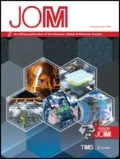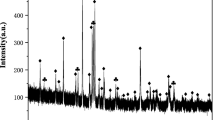Summary
Outokumpu Oy has intensively studied the production of high-grade copper matte in a flash smelting furnace since the 1950s. Blister copper was first produced in the pilot furnace of the Metallurgical Research Centre at Pori in 1969 and the first commercial plant for direct blister production was commenced in 1978 in Poland. This paper is a survey on the effect of oxygen potential or matte grade on the metallurgy of smelting copper concentrates in a flash smelting furnace. Increasing the matte grade in the smelting step improves the smelter operation in many ways. For instance, it increases the use of the combustion energy of concentrates, converts a higher portion of sulfur to a continuous and concentrated gas stream, decreases matte handling, and gives less fugitive gas. However, copper recirculation via slag cleaning increases. In general, the volatilization of harmful impurities slightly decreases when increasing the matte grade in flash smelting. Simultaneously, the partition coefficients of minor elements between matte and slag normally decline, so that higher portions of impurities are slagged when there are higher oxygen potentials. Only the responses of arsenic, antimony, and bismuth are somewhat different at higher matte grade.
Similar content being viewed by others
References
S. Härkki, O. Aaltonen, and T. Tuominen, “High Grade Matte Production with Oxygen Enrichment by the Outokumpu Flash Smelting Method,” Extractive Metallurgy of Copper, edited by J.C. Yannopoulos and J.C. Agarwal, The Metallurgical Society of AIME, New York 1976, pp. 488–507.
T. Nagano, and T. Suzuki, “Commercial Operation of Mitsubishi Continuous Copper Smelting and Converting Process,” Ibid., pp. 439–457.
L.A. Mills, G.D. Hallet, and C.J. Newman, “Design and Operation of the Noranda Process Continuous Smelter,” Ibid., pp. 458–487.
W.G. Davenport, “Copper Smelting to the Year 2000,” CIM Bulletin, January 1980, pp. 152–158.
S. Härkki, et al., Internal Reports, Outokumpu Oy, Harjavalta Smelter, 1962–1965.
T. Mäntymäki, et al., Internal Report, Outokumpu Oy, Harjavalta Smelter, 1969.
V. Lampiaho, et al., Internal Report, Outokumpu Oy, Harjavalta Smelter, 1972
A. Yazawa, “Thermodynamic Considerations of Copper Smelting,” Can. Metallurg. Quart., 13 (1974), pp. 443–453.
S. Mäkipirtti, Docent lecture, Outokumpu Oy report, 1973.
H. Jalkanen, “Copper and Sulphur Solubilities in Silica Saturated Iron Silicate Slags from Copper Mattes,” Scand. J. Metallurgy, 10 (1981), pp. 177–184.
K.B. Murden, “Smelting in the 80’s,” Extraction Metallurgy’ 81, IMM, London, September 21–23, 1981, pp. 208–213.
B. Andersson, P. Hanniala, and S. Härkki, “Use of Oxygen in the Outokumpu Flash Smelting Process,” Met. Soc. CIM, Hamilton, Ont., August 1981.
G.H. Kaiura, J.M. Toguri, and G. Marchant, “Viscosity of Fayalite Based Slag,” Met Soc. CIM, Annual Volume 1977, pp. 156–160.
M. Nagamori, and P.J. Mackey, “Thermodynamics of Copper Matte Converting: Part I, Fundamentals of the Noranda Process,” Met. Trans., 9B (1978), pp. 255–265.
M. Nagamori, and P.J. Mackey, “Thermodynamics of Copper Matte Converting: Part II. Distribution of Au, Ag, Pb, Zn, Ni, Se, Te, Bi, Sb and As between Copper, Matte and Slag in the Noranda Process,” Met. Trans., 9B (1978), pp. 567–579.
P.J. Mackey, “The Physical Chemistry of Copper Smelting Slags — A Review,” Met. Soc. CIM, Halifax N.S., August 24–28, 1980.
J. Juusela, and J. Mäkinen, “Advanced Smelting of Copper Concentrates by the Outokumpu Flash Smelting Method.” The IInd International Symposium on Management of Copper Resources, Lubin, Poland, April 27–28, 1977.
H. Tuovinen, and P. Setälä, “Removal of Harmful Impurities from Iron, Copper, Nickel and Cobalt Concentrates and Ores,” The 111th AIME Annual Meeting, February 14–18, 1982, Dallas, Texas.
J. Juusela, J. Myyri, and J. Sulanto, Internal Report, Outokumpu Oy, Harjavalta Smelter, 1978.
Rights and permissions
About this article
Cite this article
Mäkinen, J.K., Jåfs, G.A. Production of Matte, White Metal, and Blister Copper by Flash Furnace. JOM 34, 54–59 (1982). https://doi.org/10.1007/BF03338029
Published:
Issue Date:
DOI: https://doi.org/10.1007/BF03338029




